
April 25
1859 Ground broken for Suez Canal:
At Port Said, Egypt, ground is broken for the Suez Canal, an artificial waterway intended to stretch 101 miles across the isthmus of Suez and connect the Mediterranean and the Red seas. Ferdinand de Lesseps, the French diplomat who organized the colossal undertaking, delivered the pickax blow that inaugurated construction.
Artificial canals have been built on the Suez region, which connects the continents of Asia and Africa, since ancient times. Under the Ptolemaic rulers of Egypt, a channel connected the Bitter Lakes to the Red Sea, and a canal reached northward from Lake Timsah as far as the Nile River. These canals fell into disrepair or were intentionally destroyed for military reasons. As early as the 15th century, Europeans speculated about building a canal across the Suez, which would allow traders to sail from the Mediterranean to the Indian Ocean via the Red Sea, rather than having to sail the great distance around Africa's Cape of Good Hope.
The first serious survey of the isthmus occurred during the French occupation of Egypt at the end of the 18th century, and General Napoleon Bonaparte personally inspected the remains of an ancient canal. France made further studies for a canal, and in 1854 Ferdinand de Lesseps, the former French consul to Cairo, secured an agreement with the Ottoman governor of Egypt to build a canal. An international team of engineers drew up a construction plan, and in 1856 the Suez Canal Company was formed and granted the right to operate the canal for 99 years after completion of the work.
Construction began in April 1859, and at first digging was done by hand with picks and shovels wielded by forced laborers. Later, European workers with dredgers and steam shovels arrived. Labor disputes and a cholera epidemic slowed construction, and the Suez Canal was not completed until 1869—four years behind schedule. On November 17, 1869, the Suez Canal was officially inaugurated in an elaborate ceremony attended by French Empress Eugenie, wife of Napoleon III. Ferdinand de Lesseps would later attempt, unsuccessfully, to build a canal across the Isthmus of Panama. He died in 1894.
When it opened, the Suez Canal was only 25 feet deep, 72 feet wide at the bottom, and 200 to 300 feet wide at the surface. Consequently, fewer than 500 ships navigated it in its first full year of operation. Major improvements began in 1876, however, and the canal soon grew into the one of the world's most heavily traveled shipping lanes. In 1875, Great Britain became the largest shareholder in the Suez Canal Company when it bought up the stock of the new Ottoman governor of Egypt. Seven years later, in 1882, Britain invaded Egypt, beginning a long occupation of the country. The Anglo-Egyptian treaty of 1936 made Egypt virtually independent, but Britain reserved rights for the protection of the canal.
After World War II, Egypt pressed for evacuation of British troops from the Suez Canal Zone, and in July 1956 Egyptian President Gamal Abdel Nasser nationalized the canal, hoping to charge tolls that would pay for construction of a massive dam on the Nile River. In response, Israel invaded in late October, and British and French troops landed in early November, occupying the canal zone. Under pressure from the United Nations, Britain and France withdrew in December, and Israeli forces departed in March 1957. That month, Egypt took control of the canal and reopened it to commercial shipping.
Ten years later, Egypt shut down the canal again following the Six Day War and Israel's occupation of the Sinai peninsula. For the next eight years, the Suez Canal, which separates the Sinai from the rest of Egypt, existed as the front line between the Egyptian and Israeli armies. In 1975, Egyptian President Anwar el-Sadat reopened the Suez Canal as a gesture of peace after talks with Israel. Today, an average of 50 ships navigate the canal daily, carrying more than 300 million tons of goods a year. (History.com)
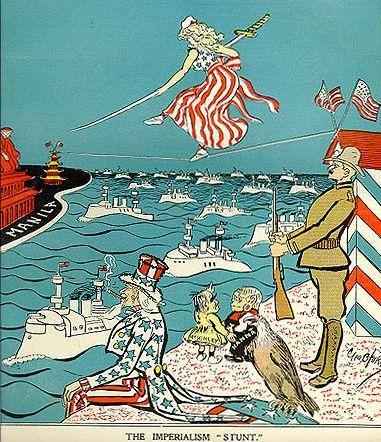
1898 Spanish-American War: The US Congress declares that a state of war between the United States and Spain has existed since April 20 (later changed to April 21). (Trask)
[See: Countdown to Infamy: Timeline to Pearl Harbor.]1900 Birth: Wolfgang Ernst Pauli:
Austrian-born physicist noted for his work on the theory of spin, and in particular the discovery of the Exclusion principle, which underpins the whole of chemistry. The German annexation of Austria in 1938 made him a German citizen, which became a difficulty with the outbreak of World War II in 1939. Pauli moved to the United States in 1940, where he was Professor of Theoretical Physics at Princeton. After the end of the war, he became a naturalized citizen of the United States in 1946 before returning to Zurich, where he mostly remained for the rest of his life.
1902 Birth: Werner Heyde: German psychiatrist: one of the main organizers of Nazi Germany's T-4 Euthanasia Program:
After World War II Heyde was interned and imprisoned, but escaped in 1947. He went underground using the alias Fritz Sawade and continued practicing as sports physician and psychiatrist in Flensburg. Many friends and associates knew about his real identity, but remained silent even as he was an expert witness in court cases. His true identity was revealed in the course of a private quarrel in 1959. He was imprisoned in Frankfurt/Main, but committed suicide before the start of the trial in 1964.
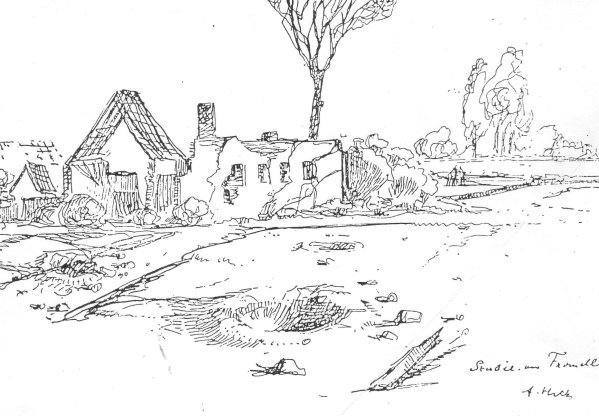
1915 World War I: Various:
List Regiment: Gefreiter Adolf Hitler's 16 Reserve Infantry Regiment occupy a position, at Fromelles (pictured above in a drawing by Hitler), which is on a level field with water channels, willow trees and willow stalks, in the distance towards the enemy lines lie an insignificant wood with barbed wire entanglements. Under the direction of their defense-minded commander, Lieutenant General Gustav Scanzoni von Lichtenfels, the regiment works ceaselessly day and night in the subsequent weeks, to further fortify their position at Fromelles. [For further details, Click here.]
Turkish front: Allies begin invasion of Gallipoli:
A week after Anglo-French naval attacks on the Dardanelles end in dismal failure, the Allies launch a large-scale land invasion of the Gallipoli Peninsula, the Turkish-controlled land mass bordering the northern side of the Dardanelles. For further details, Click here]
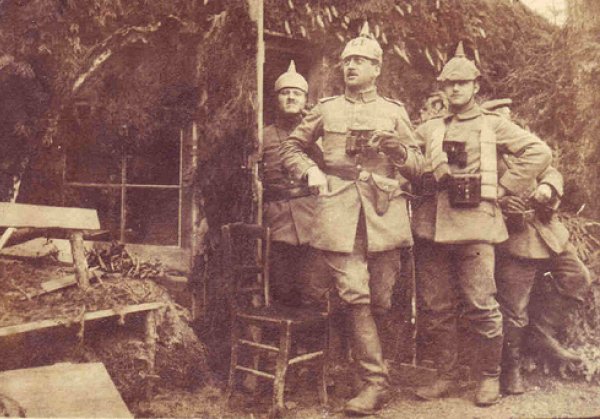
1916 World War I: Various:
List Regiment: Gefreiter Adolf Hitler endures trench warfare in Flanders (Artois) with 3 Company, 16 Reserve Infantry Regiment. [For further details, Click here.]
ANZAC Day is commemorated for the first time (See 1915):
When war broke out in 1914 Australia had been a federal commonwealth for only fourteen years. The new national government was eager to establish its reputation among the nations of the world. In 1915 Australian and New Zealand soldiers formed part of the allied expedition that set out to capture the Gallipoli peninsula to open the way to the Black Sea for the allied navies. The plan was to capture Constantinople (now Istanbul), capital of the Ottoman Empire and an ally of Germany. They landed at Gallipoli on 25 April, meeting fierce resistance from the Turkish defenders. What had been planned as a bold stroke to knock Turkey out of the war quickly became a stalemate, and the campaign dragged on for eight months. At the end of 1915 the allied forces were evacuated after both sides had suffered heavy casualties and endured great hardships. News of the landing at Gallipoli made a profound impact on Australians at home and 25 April quickly became the day on which Australians remembered the sacrifice of those who had died in war. [For further details, Click here.]
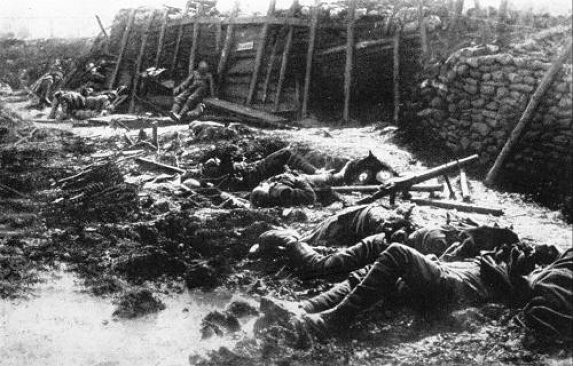
1917 World War I: List Regiment: Gefreiter Adolf Hitler's 16 Reserve Infantry Regiment, 3 Company, participate in the Arras action, being redeployed east of Vimy Ridge. [For further details, Click here.]
1918 World War I: List Regiment: Gefreiter Adolf Hitler's 16th RIR constructs fortified works in difficult defensive positions on an active front with German assault regiments near Fountaine (Montdidier). [For further details, Click here.]
1920 Polish-Soviet War: The war continues between Poland and the Soviet Union:
In 1919 the Poles had gained control of most of the disputed territories. Border skirmishes then escalated into open warfare following Pilsudski's attempt to take advantage of Russia's weakness with a major incursion into Ukraine in early 1920 (the Kiev Operation). He was met by a Red Army counterattack on April 25, 1920. This Soviet counter-offensive was very successful, throwing Polish forces back westward all the way to the Polish capital of Warsaw. Meanwhile, Western fears of Soviet troops arriving at the German frontiers increased Allied interest in the war. A French military mission, which had been operating in Poland since 1919, and was responsible for improvement of the organization and logistics of the Polish forces, was expanded up to about 600 advisors and was joined by General Maxime Weygand. For a time, in midsummer, the fall of Warsaw seemed certain. This generated great excitement among many communists in Moscow, who began to see Poland as the bridge over which communism would pass into Germany. [For further details, Click here.]
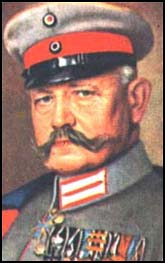
1925 Weimar: Field Marshal Paul von Hindenburg becomes the second president of Germany's postwar Weimar Republic.
Gustav Stresemann's diary entry concerning Hindenburg's victory:
There can be no doubt that the personal element won the day. During the turmoil of the election campaign there was no lack of effort to discredit the significance of Hindenburg's personality. But with little success. Many indeed were doubtful whether the burden of age might not be too heavy for one who aspired to the Presidential office. But in the end the great name produced its effect, and brought forth reserves of voters who would hardly otherwise have been available in such numbers if they had not regarded it as a patriotic duty to record their votes for the great commander in the Great War. On the other side, Hindenburg's nomination combined the Weimar Coalition even more firmly than would have otherwise been the case. Anyone acquainted with the reports of the meetings held by the Social Democratic Party at the time of the elections knows how violent was the reaction against the idea of electing a leading member of the Centre Party to the Presidency. It was opposed by the Levi Group, which saw a betrayal of the conception of the Class War in any co-operation with the Centre bourgeoisie. It was opposed by the whole body of Freethinkers—and where are these stronger than in the ranks of the Social Democratic Party?—who had no notion of voting for the champion of denominational schools, and the avowed supporter of the Christian attitude to the State and the world. It was opposed above all by the women in the areas where the denominational conflict is acute, owing to their fear that the election of Marx would lead to a strengthening of Catholicism. And the opposition was much more intense among the Democrats. Not only from Bavaria came protests against the support of the Centre candidate. In other districts, too, the Democratic creed was shaken.
1933 Holocaust: Various:
The Kaiser Wilhelm Institute receives a letter from the Ministry of the Interior containing directions that the law for the restoration of the professional civil service be applied to the society's employees. Two days later, the Secretary General instructs the directors to carry out these measures. (THP)
The Law for Preventing Overcrowding in German Schools and Colleges is promulgated, limiting admittance to 1.5 percent for "non-Aryans" seeking higher education.
1938 Holocaust: Germany: Nazis stage anti-Jewish riots in Theusing.
1941 World War II: From a letter from Bormann to Rosenberg:
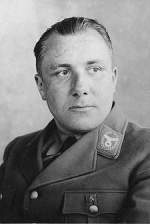
We are inducing schools more and more to reduce and abolish morning religious services. Similarly the confessional and general prayers in several parts of the Reich have already been replaced by National Socialist mottoes. I would be grateful to know your opinion on a future National Socialist morning service instead of the present confessional morning services which are usually conducted once per week.
1942 Holocaust: Germany: 105 Jews from Bamberg are deported to Izbica and Belzec. (THP)
1943 World War II: Various:
The Demyansk Shield for German troops, commemorating the Demyansk Pocket, is instituted.
Holocaust: Warsaw ghetto: From the SS and Police Fuehrer in the District of Warsaw to the Higher SS and Police Fuehrer East:
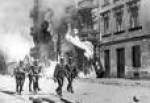
A total of 1,960 Jews were caught alive. The Jews informed us that among them were certain parachutists who were dropped here and bandits who had been equipped with arms from some unknown source. 274 Jews were killed. As in the preceding days, uncounted Jews were buried in blown up dug-outs and, as can be observed time and again, burned with this bag of Jews today. We have, in my opinion, caught a very considerable part of the bandits and lowest elements of the Ghetto. Intervening darkness prevented immediate liquidation. I am going to try to obtain a train for T II tomorrow. Otherwise liquidation will be carried out tomorrow. Today also, some armed resistance was encountered; in a dug-out three pistols and some explosives were captured. Furthermore, considerable amounts of paper money, foreign currency, gold coins, and jewelry were seized today.
1944 World War II: Three thousand Jewish soldiers (from a total of 4,200) have deserted the Polish Army in the Middle East. Some join British units or enter terrorist [or activist, depending which side you're on] groups like the Irgun. Among them is Menachem Begin. About 838 Jews will remain in Polish uniform to fight the Nazis.
[See: Jewish War Heroes.]1945 World War II: Various:
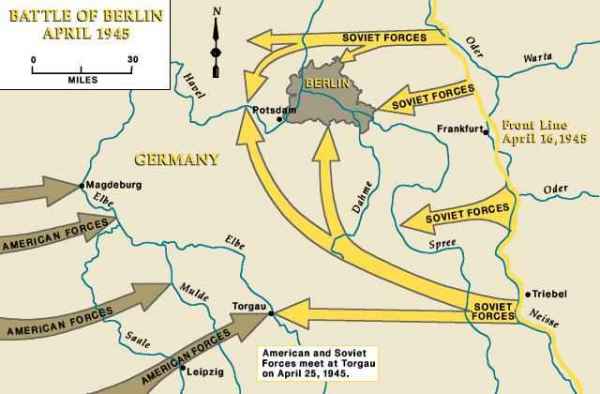
Americans and Russians link up:
Eight Russian armies completely encircle Berlin, linking up with the U.S. First Army patrol, first on the western bank of the Elbe, then later at Torgau. Germany is, for all intents and purposes, Allied territory.
The Allies sounded the death knell of their common enemy by celebrating. In Moscow, news of the link-up between the two armies resulted in a 324-gun salute; in New York, crowds burst into song and dance in the middle of Times Square. Among the Soviet commanders who participated in this historic meeting of the two armies was the renowned Russian Marshal Georgi K. Zhukov, who warned a skeptical Stalin as early as June 1941 that Germany posed a serious threat to the Soviet Union. Zhukov would become invaluable in battling German forces within Russia (Stalingrad and Moscow) and without. It was also Zhukov who would demand and receive unconditional surrender of Berlin from German General Krebs less than a week after encircling the German capital. At the end of the war, Zhukov was awarded a military medal of honor from Great Britain. [For further details, Click here]
Soviet forces surround Berlin:
While this was going on, Zhukov and Koniev had completed the encirclement of the city by 25 April and started to close in to what Goebbel's Propaganda Ministry was describing as 'Fortress Berlin'. While the city had been preparing for a siege since January, the defences were still rudimentary and makeshift due to the lack of resources — certainly no match for the forces that were about to assault them but the defending forces could muster almost 100,000 troops (including the LVI Panzer Corps, reinforced by the 18th Panzergrenadier and 11th SS 'Nordland' Panzergrenadier Divisions) in a variety of makeshift formations. Certainly the urban terrain, with its many canals and rivers and damage done by bombing and artillery fire, naturally favoured the defence. The main attack started the next day, with the Germans fighting tenaciously, making skilful use of buildings and rubble to conduct sniping, counterattacks and ambushes, while many of the high flak towers were able to fire down onto the advancing Soviet forces. After two days of bitter fighting, Zhukov's forces had reached Charlottenburg in the west and the River Spree in the Moabit area further east. [For further details, Click here.]
Churchill to Truman:

You will no doubt have received some hours ago the report from Stockholm by your Ambassador on the Bernadotte-Himmler talks. I called the War Cabinet together at once, and they approved the immediately following telegram, which we are sending to Marshal Stalin and repeating through the usual channels to you. We hope you will find it possible to telegraph to Marshal Stalin and to us in the same sense. As Himmler is evidently speaking for the German State, as much as anybody can, the reply that should be sent him through the Swedish Government is in principle a matter for the triple Powers, since no one of us can enter into separate negotiations. This fact however in no way abrogates General Eisenhower's or Field-Marshal Alexander's authority to accept local surrenders as they occur.
Churchill to Stalin:
The President of the United States has the news also. There can be no question, as far as His Majesty's Government is concerned, of anything less than unconditional surrender simultaneously to the three major Powers. We consider Himmler should be told that German forces, either as individuals or in units, should everywhere surrender themselves to the Allied troops or representatives on the spot. Until this happens the attack of the Allies upon them on all sides and in all theaters where resistance continues will be prosecuted with the utmost vigor.
Stalin to Churchill:

I consider your proposal to present to Himmler a demand for unconditional surrender on all fronts, including the Soviet front, the only correct one. Knowing you, I had no doubt that you would act in this way. I beg you to act in the sense of your proposal, and the Red Army will maintain its pressure on Berlin in the interests of our common cause.
[See: Worst Dictator of Modern Times: Hitler or Stalin?]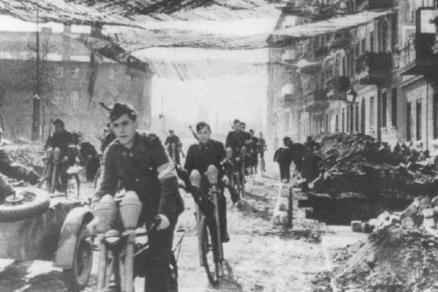
General der Artillerie Helmuth Weidling—who had earlier been sentenced to be executed by firing squad—is appointed commander of the Berlin Defense Area. Facing an advance by two and a half million battle-hardened Soviet soldiers, he has 44,600 German soldiers, 42,500 old and under-armed Volkssturm 'troops,' and 2,700 Hitler Youth with which to oppose them. (Kershaw)
[See: The Last Days of the Third Reich.]
Hitler summons Heinz Linge—who serves as his valet, as well as the chief of his personal bodyguard—to give him a set of precise instructions. He gives him the task of carrying his body from the Bunker, after he has taken his own life, and cremating it. "No one must see or recognize me after death," he emphasizes. "After seeing to the burning, go back to my room and collect everything I could be remembered by after death. Take everything—uniforms, papers, everything I've used—anything that people could say belonged to the Fuehrer. Take it outside and burn it." He allows for only one of his personal possessions to survive him; his portrait of Frederick the Great by Anton Graff. Frederick is to be spirited out of Berlin by Hitler's personal pilot, Hans Baur. (Payne)
[See: Did Adolf Hitler Really Commit Suicide?]
The US Army blows the swastika from the top of the Zeppelintribuene.
Goebbels Diary:
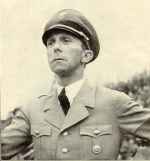
Hitler said: 'I'd regard it as a thousand times more cowardly to commit suicide on the Obersalzberg than to stand and fall here. They shouldn't say: 'You, as the Fuehrer . . . ' I'm only the Fuehrer as long as I can lead. And I can't lead through sitting somewhere on a mountain, but have to have authority over armies that obey. Let me win a victory here, however difficult and tough, then I've a right again to do away with the sluggish elements who are constantly causing an obstruction. Then I'll work with the generals who've proved themselves . . . . Only here can I attain a success, and even if it's only a moral one, it's at least the possibility of saving face and winning time . . . . Only through a heroic attitude can we survive this hardest of times . . . . It's the only chance to restore personal reputation . . . if we leave the world stage in disgrace, we'll have lived for nothing. Whether you continue your life a bit longer or not is completely immaterial. Rather end the struggle with honor than continue in shame and dishonor a few months or years longer . . . . (Goebbels adds to his Fuehrer's thoughts:) If all goes well, then it's in any case good. If things don't go well and the Fuehrer finds in Berlin an honorable death and Europe were to become bolshevized, then in five years at the latest the Fuehrer would be a legendary personality and National Socialism would have attained mythical status (ein Mythos).(Kershaw)
[See: Why Did Hitler Insist on No Surrender?]Italy: German army leaves Milan after a partisan insurrection. This day is taken as symbol of the liberation of Italy.
Holocaust: French troops stumble across evidence of mass murder and recent killings at four villages in the Swabian Alps and along the Danube. Mass graves are found of Jews evacuated from the east. With typical Gestapo thoroughness, the names, ages and birthplaces of all the victims had been recorded. The villages were Tuttlingen, Schaemberg, Schaerzlngen, and Spaichlingen. (THP)
United Nations: Delegates from some 50 countries meet in San Francisco for organizational purposes.
1946 Nuremberg Tribunal: On day 114 Hans Bernd Gisevius continues his testimony:
Gisevius: Marshal Blomberg had already asked Goering several months before whether it was permissible to have an affair with a woman of low birth, and shortly thereafter he had asked Goering whether he would help him to obtain a dispensation to marry this lady "with a past" as he put it. Later Blomberg came again and told Goering that this lady of his choice unfortunately had another lover and he must ask Goering to help him, Blomberg, to get rid of that lover.
Dr Dix: Excuse me. Goering told that to Helldorf and you learned it from Helldorf?
Gisevius: Yes, that is what Goering said, and in the further course of the investigation we learned of it from other sources too. Goering then got rid of that lover by giving him foreign currency and sending him off to South America. In spite of that, Goering did not inform Hitler of this incident. He even went with Hitler, as a witness, to the wedding. [For the full testimony, Click here.]
1946 Nurember Tribunal: From the letters of Thomas Dodd:
This has been a very interesting day. The defense witness, Gisevius, has been on the stand and as you may have read in the press he completely destroyed the defendants—man by man, with the exception of Schacht, for whom he was a good witness—but not good enough in my opinion to exculpate Schacht or to save him from punishment. Justice Jackson cross-examined him and brought out amazing and indeed shocking information about these Nazis. The defendants looked very glum—and disconsolate and indeed they might. They are a group of evil, wicked men. This is perfectly clear to me—and I have been in a position to know. Gisevius did not complete his testimony when the court adjourned for the day. He will be on again in the morning.
[See: Are There Any Lasting Effects From the Nuremberg Trials?]1983 Germany: Hitler diaries:
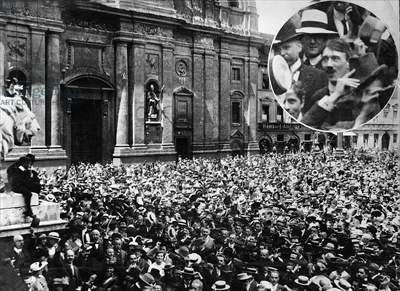
Stern magazine publishes extracts from the so-called Hitler Diaries. They are also published by the Sunday Times in Britain. They will later be found to be obvious forgeries; the biggest literary hoax in history.
[See: The Third Reich: What to Read?]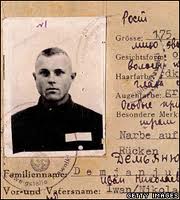
1988 Israel: John Demjanuk is sentenced to death for war crimes committed in World War II. He was accused of being a notorious guard at the Treblinka extermination camp known as "Ivan the Terrible" by survivors. Demjanjuk was placed in solitary confinement until August 1993, when five Israeli Supreme Court judges ruled that there was not enough evidence to show that Demjanjuk was Ivan the Terrible.
Edited by Levi Bookin (Copy editor)
levi.bookin@gmail.com



Click to join 3rdReichStudies


Please note that the list-owner and the moderator are not responsible for, and do not necessarily approve of, the random ads placed on our pages by our web server. They are, unfortunately, the price one pays for a 'free' website.
FAIR USE NOTICE: This site may contain copyrighted material the use of which has not always been specifically authorized by the copyright owner. We are making such material available in our efforts to advance understanding of historical, political, human rights, economic, democracy, scientific, environmental, and social justice issues, etc. We believe this constitutes a 'fair use' of any such copyrighted material as provided for in section 107 of the US Copyright Law. In accordance with Title 17 U.S.C. Section 107, the material on this site is distributed without profit to those who have expressed a prior interest in receiving the included information for research and educational purposes. If you wish to use copyrighted material from this site for purposes of your own that go beyond 'fair use', you must obtain permission from the copyright owner.